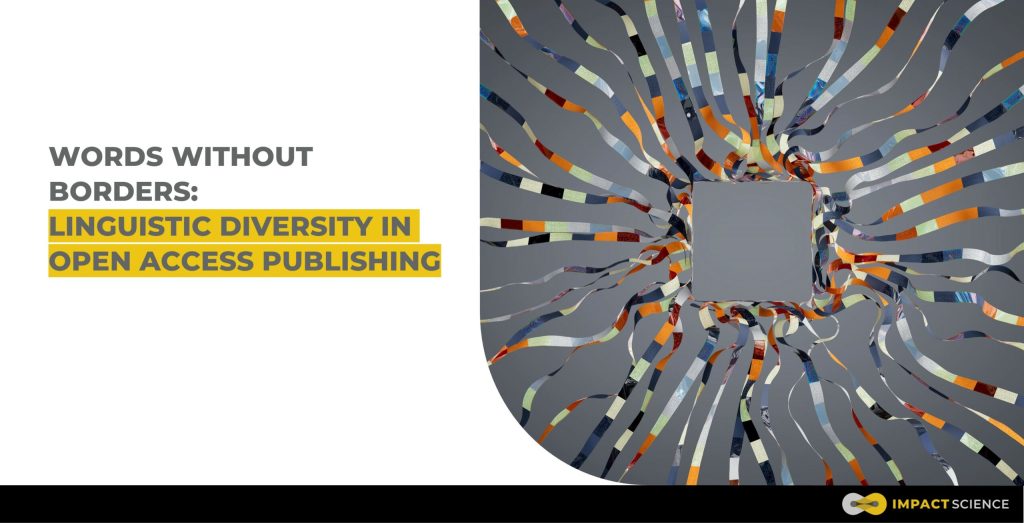English is recognized as the most extensively spoken language globally (when including both native and non-native speakers). Sadly, more than 3,000 languages are considered “endangered” today—these are languages threatened by loss because a more prevalent language is being used by community members for instructing and conversing. The prevalent language or “lingua franca” in academia is English. English as a language is believed to hold “a near monopoly of published research”—a situation expected to continue to be so.
English is the predominant language for scholarly journals, including those in open access (OA) repositories. Scientists and journals seeking more citations are pushed to publish in English instead of local languages. As a result, publications in various local languages, especially in the Global South, have diminished, even though an ever-increasing proportion of researchers belongs to non–English-speaking backgrounds. Considering the pervasive dominance of English in academic publishing, the importance of embracing linguistic diversity in this space needs to be recognized.
See also: How Publishers and Journals Can Encourage OA Submissions from Underserved Groups
Why do academia and scholarly publishing need linguistic diversity?
Electronic communication and mobilization of researchers globally are facilitating increased international scientific collaboration. This scenario should encourage rather than erode linguistic diversity. A sort of “cross-pollination” is needed to change the current homogeneity and standardization of practices in disseminating scientific knowledge, lent by the dominance of articles in English, mostly from the Global North.
UNESCO’s Recommendation concerning the Promotion and Use of Multilingualism and Universal Access to Cyberspace seeks to “promote human interaction on the Internet by encouraging the creation and processing of, and access to, educational, cultural and scientific content in digital form, so as to ensure that all cultures can express themselves and have access to cyberspace in all languages, including indigenous ones.”
A lack of language diversity can lead to an impoverishment of research on lesser-known cultures and traditional knowledge, and even a loss of local languages. Researchers and their valuable work in this space might remain undiscovered because of the lack of visibility of findings disseminated in languages besides English. Open science can help preserve local, traditional knowledge, which is typically available in local or Indigenous languages.
It is worth mentioning another crucial need for communicating research in different languages: academic communication in the native language of a target audience leads to greater participation and motivation and stronger connections to concepts in the local culture.
Thus, multilingualism is an important means to support OA and offer diverse methods to produce, communicate, and utilize knowledge.
How is OA supporting linguistic diversity in scholarly publishing?
There are currently 20,341 journals indexed in the directory of OA journals (DOAJ; the largest database of fully OA journals), representing 135 countries and covering 80 languages. About 35% of indexed journals in 2022 published articles in two or more languages.
Multilingual journals from the Global South
Asia: At present, 3,636 journals from Asia are indexed in DOAJ, and 1,253 repositories from Asia are registered on OpenDOAR. National-level digital libraries have been developed in India, Nepal, Sri Lanka, Kazakhstan, and Kuwait, with local language OA databases. A study on contributions by BIMSTEC countries (seven South Asian and Southeast Asian nations) to DOAJ found that these covered journals in Hindi, Thai, Turkish, Nepali, Arabic, and Sanskrit.
Latin America: Latin America has a long history of non-commercial OA publishing, predating the global OA movement. In their ecosystem of non-APC OA publishing, Redalyc and AmeliCA promote the inclusion of local science and linguistic diversity. Further, within the DOAJ, the predominant languages of journals after English are Spanish (3,821 journals) and Portuguese (2,450 journals); these are languages used in many Latin American nations. Of note, the Indigenous language Quechua has one journal in this database too.
Africa: In Africa, English, French, Spanish, and Portuguese are colonial languages, and in addition, there is a rich tapestry of local languages. Journals in these languages are indexed in DOAJ, including local languages like Afrikaans and Sotho.
OA initiatives promoting lingual diversity can provide much-needed global visibility to researchers of the Global South and lead to more citations by researchers in other countries.
See also: Communicating Research on Indigenous Peoples: The Role of Journals and Publishers
Open Journal Systems
Open Journal Systems (OJS), a free and open source software application for publishing scholarly journals online, is used by over 25,000 journals, most of which originate in the Global South. OJS is multilingual and has been translated into over 50 languages.
Helsinki Initiative
The Helsinki Initiative on Multilingualism in Scholarly Communication was conceptualized in 2019. Signatories support three salient recommendations to be adopted by policy-makers, universities and research institutions, funders, libraries, and researchers:
- Supporting the dissemination of research findings for the benefit of the society
- Supporting the publication of locally relevant research
- Promoting language diversity in research assessment, evaluation, and funding.
How can multilingualism be promoted in publishing?
Besides current initiatives, some more ways in which the publishing landscape can work towards increasing linguistic diversity are as follows:
- Journals can have websites in more than one language. Article titles, abstracts, and keywords can be made available in all languages. Further, the use of translation apps and multimedia formats like videos may be encouraged.
- Multilingual editorial teams can boost the prospects of language diversity in scholarly publishing.
- Scholarly journals can encourage content translation by licensing materials for transformation and creation.
- Scientometric indicators supporting the representation of diverse languages in academic discourse may be developed, similar to one suggested by Linkov et al. in 2021. Such indices, going beyond traditional citation metrics, may be used to measure impact and reward researchers publishing in languages besides English.
See also: 8 Ways Academic Journals and Publishers Can Encourage Diversity Among Authors
Closing thoughts
Linguistic diversity promotes effective scholarly communication and upholds the tenets of open science. Lingual diversity has the power to preserve locally relevant research and create impact for multilingual researchers from diverse geographies and cultures. An environment where local languages are valued and supported in academia not only preserves cultural richness but also promotes equitable access to knowledge across diverse communities worldwide. Encouraging linguistic diversity in academic publishing is not merely a matter of preserving languages but a commitment to inclusivity, enabling a more comprehensive and representative global exchange of ideas and research.









